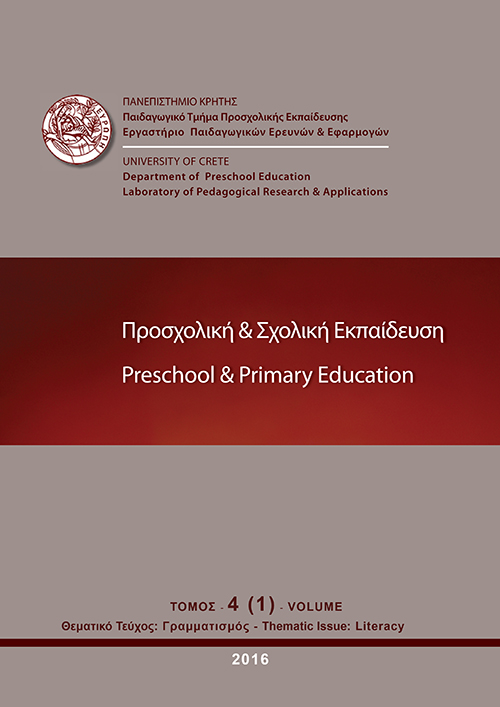Digital literacy practice cultivation: a crative challenge for the modern school
Abstract
This paper concerns digital literacy as a main dimension of social literacy in general, and especially as an important aspect of multimodal literacy. The main purpos-es of the paper (on a theoretical level) are the following: a) the definition of the nature and the main aspects and principles of digital literacy, which is regarded as not explicitly and sufficiently defined in an era of information and advanced technology; b) the presentation and analysis of students’ cognitive schemata (formal and content), which are a prerequisite for the cultivation of digital literacy practices, the social and linguistic aspects of digital literacy and the cultural dimension of this kind of literacy; c) the inves-tigation of ways to connect digital literacy and multimodality; d) the description of se-miotic resources and semiotic modes which are the main means for meaning making and meaning making transformation and redesigning, considered within the frame of social semiotic theory; e) finally, the discussion of some dimensions of critical digital literacy in
educational systems. Additionally, the main aims of the present paper, as a contribution to scientific research in the literacy field, are: a) to investigate the ways digital literacy practices are cultivated in Greek primary and secondary education through content analysis of the Greek language curricula and course books in secondary education and through the critical analysis of educational discourse; b) to present Greek language teachers’ attitudes towards the term and the aspects of multimodality and its location in the Greek educational system (the data about teachers’ attitudes are collected through interviews). The results of the research show that, in Greek education, digital literacy practices are considered to be an intentional process and a system of knowledge and skills (according the autonomous model of literacy) without being viewed in their social and ideological aspects within a communicative and cultural community. The considera-tion of semiotic resources and digital tools as isolated from their social context is in con-trast to language as semiotic mode, which is examined and studied in its social and cul-tural context. Also, language teachers are confused as far as the notion and the aspects of multimodality are concerned. Finally an example is provided of analysing a multimodal text positing an argument, so as to highlight the construction of meaning through a vari-ety of semiotic modes.Using this example, the content and practice of Greek language as an educational subject could be rejuvenated.
Article Details
- How to Cite
-
Mihalis, A. (2016). Digital literacy practice cultivation: a crative challenge for the modern school. Preschool and Primary Education, 4(1), 165–181. https://doi.org/10.12681/ppej.242
- Section
- Articles

This work is licensed under a Creative Commons Attribution-NonCommercial-ShareAlike 4.0 International License.
Authors who publish with this journal agree to the following terms:
- Authors retain copyright and grant the journal right of first publication with the work simultaneously licensed under a Creative Commons Attribution Non-Commercial License that allows others to share the work with an acknowledgement of the work's authorship and initial publication in this journal.
- Authors are able to enter into separate, additional contractual arrangements for the non-exclusive distribution of the journal's published version of the work (e.g. post it to an institutional repository or publish it in a book), with an acknowledgement of its initial publication in this journal.
- Authors are permitted and encouraged to post their work online (preferably in institutional repositories or on their website) prior to and during the submission process, as it can lead to productive exchanges, as well as earlier and greater citation of published work (See The Effect of Open Access).
Downloads
References
Kress, G. (2001). Sociolinguistics and Social Semiotics. In Cobley, P. (ed.), The Routledge Companion to Semiotics and Linguistics (pp. 66-82). New York: Routledge.
Kress, G. (2004). Reading Images: Multimodality, Representation and New Media. Conference Proceedings: Preparing for the future of Knowledge Presentation. Expert Forum for Knowledge Presentation. From www.knowledgepresentation.org/BuildingTheFuture/Kress2/Kress2.html
Kress, G. (2014). Multimodal Discourse Analysis. In Gee, J. P. & Handford, M. (eds.), The Routledge Handbook of Discourse Analysis (pp. 35-48). New York: Routledge.
Κουτσογιάννης, Δ. (2011). Λόγοι, μακροκείμενα και στρατηγικές κατά την αναπλαισίωση της πολυτροπικότητας στα διδακτικά εγχειρίδια νεοελληνικής γλώσσας του Γυμνασίου. Στο Πουρκός, Μ. & Κατσαρού, Ε. (επιμ.), Βίωμα, Μεταφορά και Πολυτροπικότητα: Εφαρμογές στην Επικοινωνία, την Εκπαίδευση, τη Μάθηση και τη Γνώση (550-574). Θεσσαλονίκη: Νησίδες.
McKay, S. L. & Hornberger, N. (1996). Sociolinguistics and Language Teaching. Cambridge: Cambridge University Press.
Μπουτουλούση, Ε. (2010). Πολυτροπικότητα και Πολυγραμματισμοί. Μελέτες για την Ελληνική Γλώσσα. Πρακτικά της Ετήσιας Συνάντησης του Τομέα Γλωσσολογίας του Τμήματος Φιλολογίας της Φιλοσοφικής Σχολής του Πανεπιστημίου Θεσσαλονίκης (2/3 Μαΐου 2009), 30, 411-421. Θεσσαλονίκη : Ινστιτούτο Νεοελληνικών Σπουδών.
Schiffrin, D. (2006). Discourse. In Fasold, R. & Connor – Linton, J. (eds.), An Introduction to Language and Linguistics (pp. 170-203). Cambridge: Cambridge University Press.



